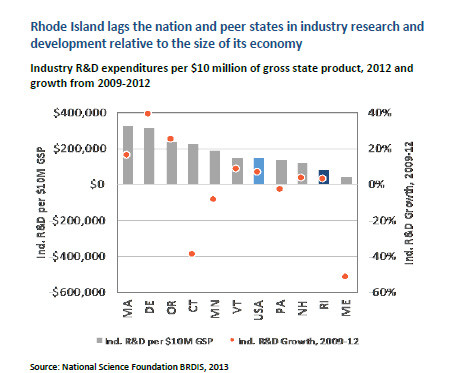
(Updated 10:18 a.m. and 2:05 p.m.)
PROVIDENCE – A six-month research effort on Rhode Island’s economy delved into the Ocean State’s past as an industrial leader, its struggles during the Great Recession and its need to innovate to move forward again.
Called “Rhode Island Innovates: A Competitive Strategy for the Ocean State,” the report was compiled by The Brookings Institution’s Metropolitan Policy Program in collaboration with TEConomy Partners and Monitor Deloitte. Gov. Gina M. Raimondo lauded the research, saying it created a strategy and concrete action steps for the state to take action.
“There’s no one big thing that’s going to save us,” Raimondo told a packed crowd at the R.I. Foundation on Tuesday. “We need a clear and comprehensive strategy to become a reality and you’ve done some great work here.”
Rhode Island can recapture some of its former glory by focusing on seven broad growth areas: biomedical innovation; information technology/software and data analytics; defense shipbuilding and maritime; advanced business services; design, food and custom manufacturing; transportation, distribution and logistics; and arts, education, hospitality and tourism, the report stated.
To that end, it suggests launching three initiatives to promote growth:
- Rhode Island Innovates, an initiative that includes targeted faculty recruitment at Rhode Island universities; a Rhode Island Global Innovation Challenge accelerator program; an entrepreneurs in residence program to attract and retain foreign entrepreneurs; and developing industry-university-laboratory collaborations in innovation districts or neighborhoods around the state, as well as training to prepare more resident for tech fields.
- Rhode Island Competes, an initiative to upgrade the state’s business environment by reforming the unemployment insurance payroll tax; modernizing the state’s permitting regulations and processes; taking Rhode Island’s e-permitting initiative statewide; reforming occupational licensing requirements; and improving Rhode Island’s rail connections by targeting new subsidies, among other ideas.
- Rhode Island Acts, an initiative to increase the state’s business-led civic engagement by establishing a business-led partnership to facilitate strategic action among private-, civic-, and public-sector leaders.
Mark Muro, senior fellow and policy director, along with other economic development professionals held a press conference on Tuesday to discuss the report’s findings.
Muro estimates the public sector would need to make an annual contribution of between $70 and $110 million to follow through on the proposed initiatives, but adds there’s “huge variations depending on how the interaction of the different sectors goes.”
But Rhode Islanders should expect to see some influence of the study in Raimondo’s upcoming fiscal 2017 budget proposal, which is expected to come out in two weeks.
“I heard the report today, I liked what I heard, [and] it’s consistent with the path we’re already on,” Raimondo told Providence Business News. “It wouldn’t be surprising at all to see [me] getting behind some of the ideas.”
Commerce Secretary Stefan Pryor, of R.I. Commerce Corporation, also cast his support behind the plan, saying it included areas that the state should invest in even further.
But the report was met with immediate scrutiny from the R.I. Center for Freedom and Prosperity, which called it an “extension of the controversial RhodeMapRI agenda that places misguided priority on targeted industries and locales, while doing little to aid average families or improve the state’s dismal business climate,” according to the group.
“Instead of a centrally planned government-centric economy that hands out more corporate welfare to targeted industries, our state needs broad-based reductions in taxes and regulations that will free up every Rhode Islander and business to organically improve their quality of life and growth in the free-market economy,” said CEO Mike Stenhouse. “How can this crony plan possibly promote the governor’s stated goal to advance equal opportunity for all Rhode Islanders.”
The report points out myriad problems facing the state – traded sectors that have been losing jobs since the 1970s that are only now stabilizing, albeit on a much smaller scale, along with stagnating incomes and increasing poverty and economic disparities. It makes note of the jobless rate, which, at 5.2 percent in November, was still highest in New England, and exceeds the pre-recession low unemployment rate of 4.8 percent.
But it also points out positives, such as an increase in state revenue that “modestly” improved the budget outlook, as well as a refinancing of state debt, new state leadership and new incentive programs aimed at encouraging growth.
The report also noted that while advanced manufacturing output growth has been negative since 2000, the state’s advanced services – information technology, computer systems design, and R&D – have performed well, boasting the highest advanced services output and employment growth in New England from 2000 to 2013. However, that represents a small employment base, the report said.
“When the state’s initial trade glory ebbed after the American Revolution, the ingenuity of Rhode Islanders prevailed, and the state not only shifted into manufacturing but also launched America’s industrial age at the Slater Mill … the state innovated, transformed its drifting economy, and prospered. Now, the state needs to do it again,” the report reads.
The report states that Rhode Island needs to leverage its assets, which include its “beautiful rocky coastline and hipness factor, to reverse substantial decline.”
“The strategies and action steps proposed here are challenging, but warranted,” the report states. “Strong actions will be necessary to locate large new sources of growth in the state, just as they were when Moses Brown and Samuel Slater triggered the state’s shift from farm to factory. Certainly the task is large, but the fact remains that Rhode Island has done it before.”
The $1.3 million project cost was funded by the Rhode Island Foundation, the Van Beuren Foundation, The Fascitelli Foundation, Mark Gallogly and Lise Strickler, Stephen and Kristin Mugford, and Thomas R. Wall, according to Brookings.
Staff writer Eli Sherman contributed to this report.












Transportation is the key to leveraging Rhode Island’s assets. Rhode Island should build a PRT mass transit system to connect the Old Colony & Newport Scenic Railway to downtown Providence using the East Bay Bike Path right of way and the East Side Railroad Tunnel. In addition, a PRT mass transit system should be built connecting Narragansett’s beach areas to the main Amtrak right of way using the William C. O’Neill Bike Path right of way. Tourists entering Rhode Island would have direct mass transit access to downtown Providence, to Newport and to Narragansett’s beaches.
As a STEAM educational advocate from Newport, I’m delighted to see that the consultants from Brookings cited the term “STEAM” 80 times within the report. Major tech employers should expect to find an organic pool of talent in RI; sadly our public educational machinery — for the most part – remains absent on the topic. Sure, there are some STEM/STEAM bright spots across the state at the high school level, but much more needs to be done. We should start with the RI Board of Education’s new strategic plan for K-12 education that doesn’t even use the word “science” once across its 49 pages. Clearly, RI’s educational policy leaders need to digest this report and get in-synch with its recommendations. Massachusetts has a 23 year, STEM-focused, head start on us. Time for Rhode Island “giddyup”?